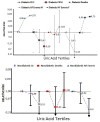Low Serum Uric Acid Predicts Risk of a Composite Disease Endpoint
- PMID: 33917823
- PMCID: PMC8068308
- DOI: 10.3390/medicina57040361
Low Serum Uric Acid Predicts Risk of a Composite Disease Endpoint
Abstract
Background and objectives: Mortality may increase in hypouricemia as well as inhyperuricemia. We assessed the predictive value of low serum uric acid (SUA) levels on the risk of overall mortality or a composite endpoint of death and nonfatal events. Materials and Methods: In 1013 community-based middle-aged adults, free of uncontrolled diabetes and coronary heart disease at baseline, the association of sex-specific SUA tertiles with defined outcomes was evaluated prospectively by logistic regression, stratified to gender and presence of type-2 diabetes, using recent criteria. Results: Totally, 43 deaths and additional incident nonfatal events in 157 cases were recorded at a median 3.4 years' follow-up. Multivariable linear regression disclosed SUA to be significantly associated among non-diabetic individuals positively with creatinine, triglycerides, and body mass index in women further with fasted glucose. In multivariable-adjusted logistic regression analysis, sex-specifically dichotomized baseline uric acid (<5.1 and <4.1 mg/dL vs. higher values) significantly predicted the non-fatal events in the whole sample (relative risk (RR) 1.51 [95% confidence interval (CI) 1.02; 2.26]), as well as in men, while composite endpoint in the whole sample tended to rise (RR 1.38). Compared with the intermediate one, the top and bottom SUA tertiles combined tended to confer mortality risk (RR 2.40 [95% CI 0.89; 6.51]). Adverse outcomes in diabetic women were predicted by tertiles 2 and 3. Conclusions: Inverse association of SUA with adverse outcomes, especially in men, is consistent with the involvement of uric acid mass in autoimmune activation. The positive association of uric acid with adverse outcomes in diabetic women is likely mediated by concomitant high-density lipoprotein dysfunction.
Keywords: coronary heart disease; diabetic status; mortality; serum uric acid; smoking status; total cholesterol.
Conflict of interest statement
The authors declare no conflict of interest.
Figures


Similar articles
-
Serum uric acid shows a J-shaped trend with coronary mortality in non-insulin-dependent diabetic elderly people. The CArdiovascular STudy in the ELderly (CASTEL).Acta Diabetol. 2007 Sep;44(3):99-105. doi: 10.1007/s00592-007-0249-3. Epub 2007 Aug 26. Acta Diabetol. 2007. PMID: 17721747
-
Prediction by Low Plasma HbA1c of Mortality, Cardiac and Noncardiac Disease Risk: Modulation by Diabetic Status and Sex.J Investig Med. 2015 Aug;63(6):821-7. doi: 10.1097/JIM.0000000000000216. J Investig Med. 2015. PMID: 26107424
-
Relationship between serum uric acid levels and hepatic steatosis in non-obese postmenopausal women.Climacteric. 2014 Dec;17(6):692-9. doi: 10.3109/13697137.2014.926323. Epub 2014 Aug 7. Climacteric. 2014. PMID: 24884478
-
Associations of serum uric acid with total and cause-specific mortality: Findings from individuals and pooling prospective studies.Atherosclerosis. 2020 Mar;296:49-58. doi: 10.1016/j.atherosclerosis.2019.07.019. Epub 2019 Jul 20. Atherosclerosis. 2020. PMID: 32032905
-
Prognostic value of serum uric acid in patients with acute heart failure: A meta-analysis.Medicine (Baltimore). 2019 Feb;98(8):e14525. doi: 10.1097/MD.0000000000014525. Medicine (Baltimore). 2019. PMID: 30813158 Free PMC article. Review.
Cited by
-
U-shaped association of uric acid to HDL cholesterol ratio (UHR) with ALL-cause and cardiovascular mortality in diabetic patients: NHANES 1999-2018.BMC Cardiovasc Disord. 2024 Dec 27;24(1):744. doi: 10.1186/s12872-024-04436-3. BMC Cardiovasc Disord. 2024. PMID: 39725874 Free PMC article.
-
Higher serum uric acid levels and risk of all-cause mortality in general population: a systematic review and meta-analysis.Metabol Open. 2025 May 16;26:100371. doi: 10.1016/j.metop.2025.100371. eCollection 2025 Jun. Metabol Open. 2025. PMID: 40491671 Free PMC article.
References
-
- Mazzali M., Kanellis J., Han L., Feng L., Xia Y.-Y., Chen Q., Kang D.-H., Gordon K.L., Watanabe S., Nakagawa T., et al. Hyperuricemia induces a primary renal arteriolopathy in rats by a blood pressure-independent mechanism. Am. J. Physiol. Physiol. 2002;282:F991–F997. doi: 10.1152/ajprenal.00283.2001. - DOI - PubMed
MeSH terms
Substances
LinkOut - more resources
Full Text Sources
Other Literature Sources
Medical

